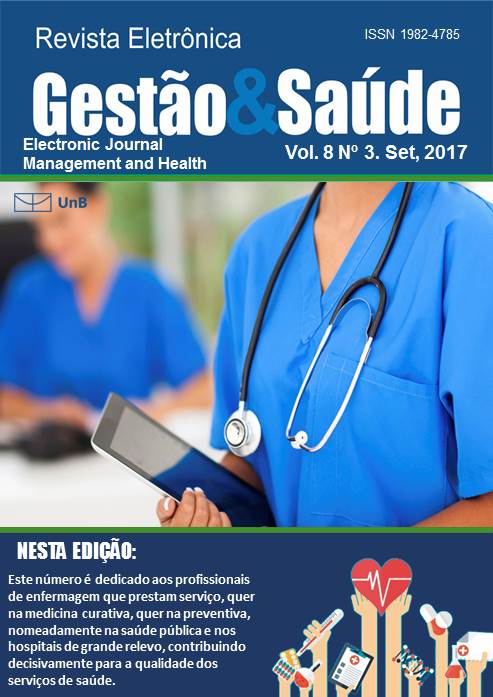Assessing risk of medication errors: a case study in a teaching hospital
Mots-clés :
Temas Livres em SaúdeRésumé
In the health care process, patients are subjected to different hazards. Medication error is one of the most frequent causes of adverse events in hospitals. A risk assessment can provide evidence for the development of an action plan to mitigate, reduce or eliminate these hazards. The objective is to evaluate the risks to patients in the process of drug administration in a university hospital. A case study was carried out in a Brazilian teaching hospital with the use of the Failure Modes and Effects Analysis (FMEA) technique. Failures considered as high risks to cause adverse events to patients are exchange of drugs delivered for dispensing, drug identified with the wrong label at the unitization process, lack of prescription standard for dose abbreviation, patient exchange due to inattention or name similarity, request for emergency care without prescription, and drug sent on the wrong shift. The use of FMEA was suitable for the identification and prioritization of risks, providing a basis to develop an action plan to enhance safety.
Téléchargements
Références
Hebert L, Localio AR, Lawthers AG, et
al. Incidence of Adverse Events and
Negligence in Hospitalized Patients:
Results of the Harvard Medical Practice
Study I. N Engl J Med.
1991;324(6):370”“6.
2. Leape LL, Brennan TA, Laird N,
Lawthers AG, Localio AR, Barnes BA,
et al. The Nature of adverse events in
hospitalized patients - Results of the
Harvard Medical Practice Study II. N
Engl J Med. 1991;324(6):377”“84.
3. Baker GR, Norton PG, Flintoft V, Blais
R, Brown A, Cox J, et al. The Canadian
Adverse Events Study: the incidence of
adverse events among hospital patients
in Canada. Can Med Assoc J.
2004;170(11):1678”“86.
4. de Vries EN, Ramrattan MA,
Smorenburg SM, Gouma DJ,
Boermeester MA. The incidence and
nature of in-hospital adverse events: a
systematic review. Qual Saf Health
Care. 2008;17:216”“23.
5. Documento de referência para o
Programa Nacional de Segurança do
Paciente / Ministério da Saúde;
Fundação Oswaldo Cruz; Agência
Nacional de Vigilância Sanitária.
Brasília: Ministério da Saúde; 2014. p.
40.
6. Runciman WB, Hibbert P, Thomson R,
Van Der Schaaf T, Sherman H, Lewalle
P. Towards an International
Classification for Patient Safety: key
concepts and terms. Int J Qual Heal
Care. 2009;21(1):18”“26.
7. Manual de Erros de Medicação -
Definições e Estratégias de Prevenção.
São Paulo: Conselho Regional de
Enfermagem do Estado de São Paulo
(COREN-SP) e Rede Brasileira de
Enfermagem e Segurança do Paciente;
2011.
8. Reason J. Understanding adverse
events: human factors. Qual Heal Care.
1995;4(2):80”“9.
9. Leape L, Berwick D, Clancy C, Conway
J, Gluck P, Guest J, et al. Transforming
healthcare: a safety imperative. Qual
Saf Health Care. 2009;18(6):424”“8.
10. Pritchard CL. Risk Management:
Concepts and Guidance. Virginia: ESI
International; 1997. 218 p.
11. Kessels-Habraken M, Van der Schaaf T,
De Jonge J, Rutte C, Kerkvliet K.
Integration of prospective and
retrospective methods for risk analysis
in hospitals. Int J Qual Heal Care.
2009;21(6):427”“32.
12. Adibi H, Khalesi N, Ravaghi H, Jafari
M, Jeddian AR. Development of an
effective risk management system in a
teaching hospital. J Diabetes Metab
Disord. 2012;11(1):15.
13. Alástico GP, Toledo JC. Acreditação
Hospitalar”¯: proposição de roteiro para
implantação. Gestão & Produção.
2013;20(4):815”“31.
14. Bonnabry P, Cingria L, Sadeghipour F,
Ing H, Fonzo-Christe C, Pfister RE. Use
of a systematic risk analysis method to
improve safety in the production of
paediatric parenteral nutrition solutions.
Qual Saf Health Care. 2005;14(2):93”“8.
15. Cagliano AC, Grimaldi S, Rafele C. A
systemic methodology for risk
management in healthcare sector. Saf
Sci. Elsevier Ltd; 2011;49(5):695”“708.
16. DeRosier J, Stalhandske E, Bagian JP,
Nudell T. Using health care failure
mode and effect analysisTM: the VA
National Center for Patient Safety’s
prospective risk analysis system. Jt
Commision J Qual Improv.
2002;28(5):248”“67.
17. Lepage B, Robert R, Lebeau M,
Aubeneau C, Silvain C, Migeot V. Use
of a risk analysis method to improve
care management for outlying inpatients
in a university hospital. Qual Saf Health
Care. 2009;18(6):441”“5.
18. Marx DA, Slonim AD. Assessing
patient safety risk before the injury
occurs: an introduction to sociotechnical
probabilistic risk modelling in health
care. Qual Saf Health Care. 2003;12
Suppl 2:ii33”“8.
19. Runciman WB, Williamson JAH,
Deakin A, Benveniste KA, Bannon K,
Hibbert PD. An integrated framework
for safety, quality and risk management:
an information and incident
management system based on a
universal patient safety classification.
Qual Saf Health Care. 2006;15 Suppl
1:i82”“90.
20. Failure Mode and Effects Analysis in
Health Care: Proactive Risk Reduction.
USA: Joint Commission International;
2010. p. 154.
Téléchargements
Publié-e
Comment citer
Numéro
Rubrique
Licence
Declaro que o presente artigo é original, não tendo sido submetido à publicação em qualquer outro periódico nacional ou internacional, quer seja em parte ou em sua totalidade. Declaro, ainda, que uma vez publicado na Revista Gestão & Saúde editada pela Universidade de Brasília, o mesmo jamais será submetido por mim ou por qualquer um dos demais coautores a qualquer outro meio de divulgação científica.
Através deste instrumento, em meu nome e em nome dos demais coautores, porventura existentes, cedo os direitos autorais do referido artigo à Revista Gestão & Saúde e declaro estar ciente de que a não observância deste compromisso submeterá o infrator a sanções e penas previstas na Lei de Proteção de Direitos Autorias (Nº9609, de 19/02/98).


 Revista Eletrônica Gestão & Saúde está licenciado com uma Licença
Revista Eletrônica Gestão & Saúde está licenciado com uma Licença 